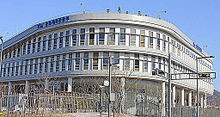Ministry of Culture, Sports and Tourism
South Korean government agency From Wikipedia, the free encyclopedia
The Ministry of Culture, Sports and Tourism (MCST; Korean: 문화체육관광부) is a central government agency of South Korea responsible for the areas of tourism, culture, art, religion, and sports. It has two vice ministers, three assistant ministers, one commission, and over 60 divisions. The first Minister of Culture was novelist Lee O-young.[2]
| 문화체육관광부 文化體育觀光部 Munhwa Cheyuk Gwangwang-bu | |
 MCST headquarters in Sejong City | |
| Agency overview | |
|---|---|
| Formed | February 29, 2008[1] |
| Preceding agencies |
|
| Jurisdiction | Government of South Korea |
| Headquarters | Sejong City, South Korea |
| Minister responsible | |
| Deputy Ministers responsible |
|
| Child agency | |
| Website | mcst.go.kr |

Subsidiary entities such as the National Museum, the National Theater, and the National Library are under the Ministry.
The headquarters are located in the Sejong Government Complex in Sejong City.[3] The headquarters were previously in Jongno District, Seoul.[4]
History
Summarize
Perspective
The Ministry of Culture and Tourism was originally a sub-organization of the Ministry of Education created in 1948. Later, the Ministry of Transportation set up a tourism department. The Ministry of Information was set up in 1961 for administration of art and cultural affairs. The Ministry of Culture and Information became the Ministry of Culture in 1990.[5]
In 1993, the Ministry of Culture was integrated with the Ministry of Youth and Sports to become the Ministry of Culture and Sports. In 1998, as part of government reorganization efforts, the Ministry of Culture and Sports was replaced by the Ministry of Culture and Tourism. It was created to invest in and support the entertainment industry, as Korea needed new areas of growth in the wake of the Asian financial crisis in the 1990s.[6]
President Kim Dae Jung put forth industrial policies supporting entertainment with the same regard as traditional industrial sectors such as manufacturing. Investments were made in both infrastructure and technology to support K-pop, including concert halls and visual effects technology. In addition, government regulation of karaoke bars favored K-pop.[7] The government believes that promoting Korean pop culture would improve people's view of the country and help with business and tourism.[8]
The Ministry developed the Korea Open Government License (KOGL), a copyright license that allows for the use and distribution of public materials.[9]
In 2012 the Ministry established an advisory committee on how to sustain the Korean wave (Hallyu).[8] In 2013, the Ministry allocated 319 billion won (US$280 million) to support Hallyu.[10]
Mission and budget
The ministry has justified its Hallyu budget by linking it to Korea's "export-led economic development". In 2012 it estimated that the Korean wave was worth US$83.2 billion, of which US$5.26 billion was attributable to K-pop.[10]
Some in the K-pop industry have criticized the ministry for not directly supporting K-pop while fattening related industries such as Hangul, K-drama, Korean food, fashion, sports, and traditional folk music. These interest groups that have been lobbying the government for inclusion in the Hallyu budget.[10]
Korean Culture and Information Service
The Korean Culture and Information Service is a department of the MCST that aims to bring Korean culture closer to the rest of the world while improving the national image of Korea. It is also responsible for setting up more than 20 Korean Cultural Centers around the world.[11]
List of ministers
| No. | Portrait | Name | Term of office | President | ||
|---|---|---|---|---|---|---|
| Took office | Left office | Time in office | ||||
| Minister of Culture, Sports and Tourism (2008-present) | ||||||
| 44 |  |
Yu In-chon | 29 February 2008 | 26 January 2011 | 2 years, 332 days | Lee Myung-bak |
| 45 |  |
Choung Byoung-gug | 27 January 2011 | 16 September 2011 | 232 days | |
| 46 |  |
Choe Kwang-shik | 17 September 2011 | 10 March 2013 | 1 year, 174 days | |
| 47 |  |
Yoo Jin-ryong[12][13][14] | 11 March 2013 | 16 July 2014 | 1 year, 127 days | Park Geun-hye |
| 48 |  |
Kim Jong-deok[15] | 20 August 2014 | 4 September 2016 | 2 years, 15 days | |
| 49 |  |
Cho Yoon-sun[16][17][18] | 5 September 2016 | 20 January 2017 | 137 days | |
| 50 |  |
Do Jong-hwan[19] | 16 June 2017 | 2 April 2019 | 1 year, 290 days | Moon Jae-in |
| 51 |  |
Park Yang-woo | 3 April 2019 | 10 February 2021 | 1 year, 313 days | |
| 52 |  |
Hwang Hee | 11 February 2021 | 12 May 2022 | 1 year, 90 days | |
| 53 |  |
Park Bo-gyoon | 13 May 2022 | 7 October 2023 | 1 year, 147 days | Yoon Suk-yeol |
| 54 |  |
Yu In-chon | 7 October 2023 | Incumbent | 1 year, 127 days | |
See also
Notes and references
External links
Wikiwand - on
Seamless Wikipedia browsing. On steroids.
